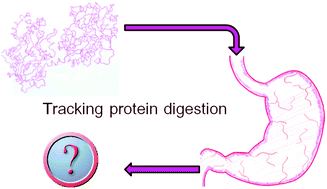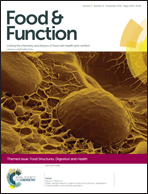Digestion proteomics: tracking lactoferrin truncation and peptide release during simulated gastric digestion†
Abstract
The extent to which nutritional and functional benefit is derived from proteins in food is related to its breakdown and digestion in the body after consumption. Further, detailed information about food protein truncation during digestion is critical to understanding and optimising the availability of bioactives, in controlling and limiting allergen release, and in minimising or monitoring the effects of processing and food preparation. However, tracking the complex array of products formed during the digestion of proteins is not easily accomplished using classical proteomics. We here present and develop a novel proteomic approach using isobaric labelling to mapping and tracking protein truncation and peptide release during simulated gastric digestion, using bovine lactoferrin as a model food protein. The relative abundance of related peptides was tracked throughout a digestion time course, and the effect of pasteurisation on peptide release assessed. The new approach to food digestion proteomics developed here therefore appears to be highly suitable not only for tracking the truncation and relative abundance of released peptides during gastric digestion, but also for determining the effects of protein modification on digestibility and potential bioavailability.

- This article is part of the themed collection: Food Structures, Digestion and Health International Conference

 Please wait while we load your content...
Please wait while we load your content...